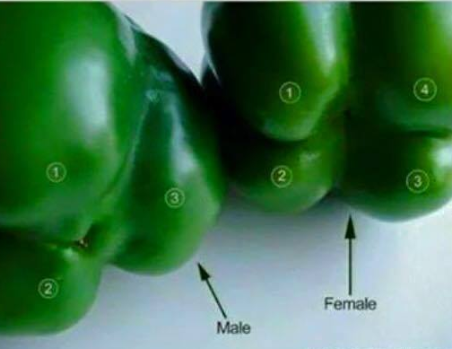Today’s post is focusing on, and celebrating the many benefits of, the amazing sweet bell peppers. There are many little known facts about bell peppers, and we’ll be getting into those in depth, too.

Many people are unaware of the long list of health benefits bell peppers have, and I will get into that in depth a little later. But first, here are some fun facts you may not know about them:
While most people consider peppers as a vegetable, they are, in fact, fruits. They grow on flowering plants and have seeds, thus making them a part of the fruit family.
And get this – bell peppers have sex!
Yes, you read that correctly, there are male and female bell peppers. If you turn them upside down, look at how many lobes they have.

The peppers with three lobes are male, and the females will have four.
 Female peppers are full of seeds, much more so than the male, and are the sweeter of the two. They are best eaten raw, as in salads or finger food appetizers, also good in stir fry dishes. The males have far less seeds, and are not as sweet, making them better for use in baked dishes.
Female peppers are full of seeds, much more so than the male, and are the sweeter of the two. They are best eaten raw, as in salads or finger food appetizers, also good in stir fry dishes. The males have far less seeds, and are not as sweet, making them better for use in baked dishes.
You can buy red, orange and yellow bell peppers, but in reality all bell peppers are green to begin with. They change color, progressing from green, to yellow, to orange, and finally red the longer they ripen. Yes, horticulture has produced seeds for each of the various colors of bell peppers, and those peppers will turn the desired color faster, but in essence all bell peppers are green in origin. You don’t have to buy “red” bell pepper seeds to grow them. Plant green bell pepper seeds and just let them ripen until they turn red.
The longer bell peppers ripen, the sweeter they get. So, red bell peppers are the sweetest tasting.
In the USA, green bell peppers are the most popular for use in meal entrees, but the other colors of bell peppers are considered desirable for salads and for adding appealing color to many dishes.
“Capsicum Annum” is the scientific name for bell peppers, and in Australia they are called capsicums.
Historians generally agree that Christopher Columbus and Spanish Conquistadors gave peppers their name.


Columbus was in search of peppercorn plants to produce black pepper and, while in the Americas, he gathered seeds from a wide variety of pepper shrubs indigenous to America. Columbus took the seeds back with him to Europe, where they were successfully cultivated, and soon became immensely popular for use as a spice as well as a food and an ingredient in many dishes.
With the Spanish and English colonization of African countries, the bell pepper was brought to that continent, where it also gained favoritism among Africans as a splendid food item. The bell pepper also made its way into the Asian countries, where it again became popular and a prominent inclusion in Asian meals.
In the United States, most of the bell peppers sold in stores are grown in Florida, with Texas, California, North Carolina also contributing a fair share. Northern states, like Michigan and Wisconsin, also grow bell peppers, but because pepper plants are only productive in very warm to hot climates, they are a seasonal plant, grown only during late June through September—with the exception, of course, of peppers grown in greenhouses.
The Many Health Benefits of Bell Peppers:
Continue reading →


















